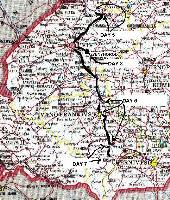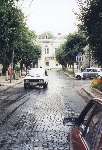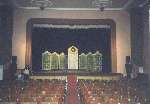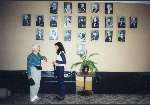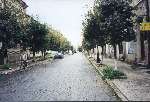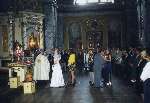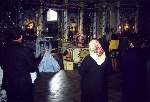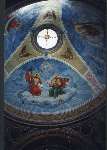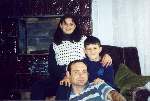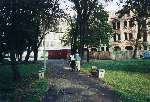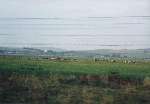|
Introduction |
TRIP TO UKRAINE
|
||
|
Saturday, September 25, 1999 Back in Kolomyia, we ate lunch before starting a tour of the city. At the bazaar in Kosiv, Dad had bought a lump of limestone. While our poor waiter (who was remarkably good- natured) fetched our soup, Dad conducted a Science Experiment, by pouring vinegar over the stone. There was no result for a while, but then it got very hot, and started steaming and crumbling. The plate was ruined, but the waiter removed it with only the slightest look of concern. I told Dad to tip him well, but didn't see whether he did. |
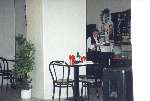
|
||
|
We had eaten dinner in this same cafe the night before, I presume because Larissa or Father Ken suggested it as safe for our tender Western tummies. While we were dining, another patron joined us to chat. He had heard us speaking English, and introduced himself as a Canadian engineer on assignment in the area to help with construction of a factory or something. He had little good to say about the area, since shortly after arrival six months earlier, he'd been mugged and beaten on the way home from a party, and had spent several months in the local hospital recovering. His story may have been the cause of our glum moods starting out the next morning. | |||
|
After lunch, I noticed the Post Office across the street. Inside the Kolomyia Post Office (and telegraph, and telephone, etc.) I needed to get some stamps for postcards I had written earlier, but I didn't have the cards with me. I just wanted some stamps! It took a while, and finally Dad's assistance, to communicate my wish simply to buy stamps for postcards to the USA. I guess most people pay only when ready to mail? The guy Dad is talking with turned out to be a refugee from Chornobyl (Чорнобиль). Although web sites like this one insist the actual deaths and illness resulting from the nuclear disaster at Chornobyl in 1986 were not major, among the people we talked to Chornobyl was a word muttered under one's breath, and every health problem was blamed on it. |
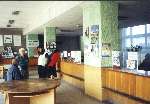
|
||
|
Larissa led us on a walking tour of her town. It was clear that she was proud of Kolomyia, and I could see why. The town has many beautiful old buildings with adornments like these, since it too escaped damage during WW II. |
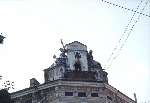
|
||
|
The Kolomyia historical-cultural museum is justly famous - we saw the most extensive and beautiful collection of costumes, pysanke, wood carvings, etc. of anywhere on our trip. I liked this map on one wall of the entrance hall, showing the differing styles of each type of craft (ceramics, embroidery, etc.) in each town of the region. Kolomyia is the point near the top from which all the lines branch out. Kosiv is the first very complex collection of stuff below and to the right. |
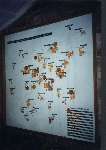
|
||
|
Staircase of the entrance hall. The building is 19th century. |

|
||
|
Unfortunately, Aside from this one photo of a model of a church altar carved by a local master, our very stern and businesslike but informative female guide forbade me to take photos in the museum. |
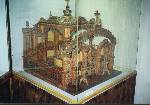
|
||
|
After our tour of the museum - Looking down the street from in front of the museum - Disco Club! I would have liked to visit it that night (it was Saturday), but we had to get back to L'viv. |
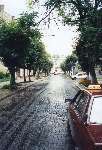
|
||
|
Kolomyia had a population at that time of about 40,000, and declining (as was all of Ukraine). The city was founded about 1100, but we saw nothing that looked older than 18th century. Here's part of one Internet reference:
|
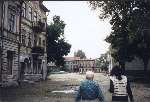
|
||
|
We looked inside the local dramatic theater, with photos of the local company in the lobby. Not bad for a town of its size. |
|||
|
Charming cobblestone streets give a bumpy ride, but were fine for walking. Where is everyone? |
|||
|
Town Hall - most of Kolomyia could use a face-lift. It was clean, but shabby, as was most of Ukraine, aside from fancy shopping streets and areas cleaned up to make a good impression (e.g. in L'viv, for the recent summit meeting there). |

|
||
| Main Street |
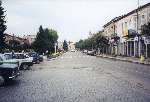
|
||
|
Another treat - Inside the largest Ukrainian Catholic church of Kolomyia, we were delighted to find a wedding in progress. In a holdover from Soviet days, the elaborate main ceremony is at the huge civil wedding palace - one in every town. More and more people are now opting for a church ceremony as well, less elaborate, but with all the traditional touches (note loaves of bread), including (in this case, at least) beautiful chanting by the priest. Later they will have the wedding dinner and dance. As in all Ukrainian Catholic churches I have seen, there are no seats. The congregation stands during all ceremonies.
Ukrainian wedding traditions: |
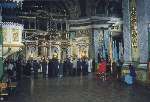
|
||
|
Same church, frescoes and painting, all new. This is now the pride of Kolomyia, completely restored, post- Communism. Looking at these pictures - wedding, etc. now, I suppose it doesn't really look any different than a Ukrainian Catholic church in Canada or the US. NOTE: I have used the term "Ukrainian Catholic" somewhat loosely in these pages - the subject is complex. Discussion of Christian churches in Ukraine |
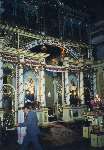
|
||
| Back on the street. |

|
||
|
THE ECONOMY in Ukraine was in terrible shape everywhere. We saw factories sitting idle and rusting. Small farming is done with horses and plows, because no one can afford tractors or other farm machinery. The large collectives produce at best half their former output, because there is now even less incentive for the workers to perform. People aren't starving, because the government at least sees to that, but it's very difficult to get ahead except through crime. Other than the few with a dedication to their country, most young people with any talent or ambition head for the West (I've heard Ukrainian spoken in my local supermarket, here in Walnut Creek). Yet in spite of the poverty, we saw few beggars, or homeless, and the ones we did see were quickly chased away by the locals. |
|||
|
Larissa said her son wanted to meet the Americans, so she took us to her apartment, introduced us to her husband and son, served tea, showed us photos. This turned out to be a mistake - Dad had been planning to give her $50 for her assistance, but told me later that he had cut that in half when he found out that her husband is both a Russian and divorced, and that they like to party. The boy studies English in school, but was shy, and after reciting a few words of it, refused to attempt conversation. |

|
||
| Time for us to leave. Ghost town. |
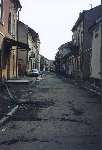
|
||
|
Larissa escorted us back to our car for our return to L'viv. |
|||
| DAY 7 - RETURN TO L'VIV | |||
|
A field north of Kolomyia - Dad, a man of the soil, collects some barley, with the assistance of Ivan, our driver, a man of infinite patience and unfailing good nature. Ivan was my favorite acquaintance of the trip, and added greatly to my enjoyment of the L'viv segment, simply by his cheeriness and reliability. |

|
||
|
Commmieblocks on the outskirts of Ivano-Frankivs'k. I was exhausted by the time we left Kolomyia, and it was getting late, so I asked for no more stops. |
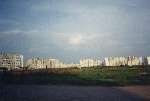
|
||
|
More villages with huge new churches glimmering in the setting sun. |
|||
|
Ivan saved us a half hour delay outside one village where all the local cows were being herded back to their homes, by taking to the fields! This was the only bit of adventurous driving he engaged in, and he was very apologetic about it. I think he was as worn out as I, and eager to get home. |
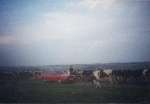
|
||
|
Back at the Hotel Dnister in L'viv, we went to the dining room for dinner, and found a big wedding celebration in progress, complete with strolling gypsy-style band. We didn't find out whose it was, but they must have been exceptionally wealthy to afford dinner for several hundred at this hotel. I was afraid they'd be keeping us up all night, but they wrapped it up early. Apparently that's the local style of wedding cake! |
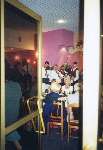
|
||
Send feedback to the author: CLICK HERE
Created -- 03/22/2007 Revised -- 03/22/2007
